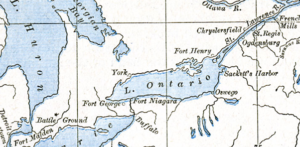James L. Yeo:
James L. Yeo:
James L. Yeo's command on Lake Ontario during the War of 1812
Christian Palombo
Port2Port - 2025
During the War of 1812, the British and the Americans fought across a vast landscape, where frontlines changed constantly due to the unpredictable nature of naval engagements. This was especially true on the Great Lakes and specifically Lake Ontario, whose control was essential to the war effort of both nations. The battles and blockades that took place on this lake played a pivotal role in shaping the outcome of the war. One of the most influential men in this theatre of the war was Sir James Lucas Yeo, a British naval commander who led efforts to defend Britain's interests in the region. Yeo was appointed to the role in 1813, bringing with him over a decade of experience in the Napoleonic Wars.1 His leadership and experience was critical in preventing the Americans from dominating the region, and therefore played an essential role in defending Canada.
Yeo's appointment in 1813 came at an important time, American forces had been in firm control of Lake Ontario at the end of 1812, as the British provincial marines were ill equipped to match the force of the American navy lead by Isaac Chauncey.2 Lake Ontario was of course vital to both British and American forces during the War of 1812, as control of it meant control of supply routes for operations in Canada and the United States. One area where the American navy established an important base was in Sacket's Harbor which had a dockyard for building naval ships.3 For this reason it was an important target for capture.
The attack on Sackett's Harbor did not go as well as British forces had hoped, in fact Yeo disagreed with his superior's decision to delay the attack awaiting more favourable conditions.4 Initially there was some success as Americans retreated to fortifications, but as American reinforcements arrived the British troops who landed there were ordered to retreat by Prevost. According to American sources, the British were protected by the gunfire from Yeo's ship.5 Ultimately the attack would be considered a failure, but in the confusion of the battle the Americans had set fire to some of the stored equipment and even a ship under construction in anticipation of the British capturing the Harbor.6 On top of this, it tied up the American navy and allowed Yeo to focus his forces elsewhere in coordination with British land forces in the direction of Stoney Creek.
On June 7th, 1813, just one day after the British victory in the Battle of Stoney Creek, Commodore Yeo's fleet caught American forces in retreat at Forty Mile Creek and destroyed/captured 16 boatloads of supplies coming from Niagara.7 Yeo's actions in the battle of Sackett's Harbor caused enough damage to the American navy that they were unable to support their troops in the Stoney Creek direction. Avoiding direct confrontation with Chancey's superior navy was an important factor in the success of Yeo's attacks which would focus on raids on weak points in the American defense.

Figure 1: Locations of Sackett's Harbor and Oswego on Lake Ontario. Stoney Creek is located at the furthest western point on the Lake.
A final example of Yeo's effectiveness can be seen in the Battle of Oswego which Yeo helped to capture in 1814.8 Originally the British had hoped that the attack and subsequent blockade attempt by Yeo's fleet would be able to capture ships and supplies bound for his rival Chauncey in Sackett's Harbor and in this respect they failed.9 Despite this Yeo realised the risk of the situation and that any error on the British side had the potential for a decisive defeat at sea against Chauncey's fleet, so he returned his fleet to Kingston. Figure 1 shows the locations of Sackett's Harbor, Oswego, and Stoney Creek along the coast of Lake Ontario.10 This map highlights their strategic significance and just how critical Yeo and his fleet's actions were to prevent an American victory. Examples like the ones provided show the very practical approach Yeo took in defending British interests in Lake Ontario. He did not achieve any decisive victories at sea against Chauncey's fleet but his "live to fight another day," attitude allowed the British to maintain parity with the Americans on the lake.
In short, Yeo's constant maneuvering and opportunistic attacks on American supplies weakening American positions along the coast of Lake Ontario were essential to the British successes in the war and maintained a balance of power on Lake Ontario. While James L. Yeo may never be remembered in the same heroic sense as other men and women during the War of 1812, his efforts to maintain naval control in Lake Ontario were essential in preventing an American victory.
-
Author Unknown, "Memoir of the public services of Sir James Lucas Yeo, knt., Captain in the Royal Navy," Naval Chronicle 24 (London: Joyce Gold, 1810), 265--85. ↩
-
Tom Malcomson, "Muster Table for the Royal Navy's Establishment on Lake Ontario during the War of 1812," The Northern Mariner 9, no. 2 (Apr. 1999), 41. ↩
-
J. Mackay Hitsman and Donald E. Graves, The Incredible War of 1812: A Military History (Spellmount, Limited Publishers, 1999), 146. ↩
-
Mackay and Graves, "The Incredible War," 147. ↩
-
Mackay and Graves, "The Incredible War," 149. ↩
-
Mackay and Graves, "The Incredible War," 149. ↩
-
Mackay and Graves, "The Incredible War," 151. ↩
-
"A few points of interest in historic Oswego," Proceedings of the New York State Historical Association 13 (1914), 45. ↩
-
MacKay and Graves, "The Incredible War," 210. ↩
-
Figure 1: [Locations of Sackett's Harbor, Oswego on Lake Ontario], map, Northern Theatre of the War of 1812, 1886. ↩

